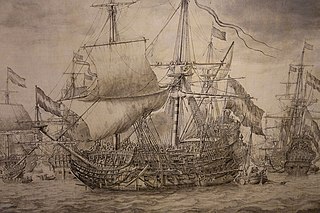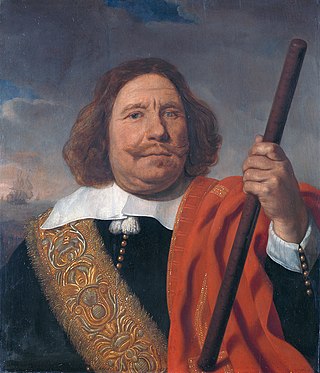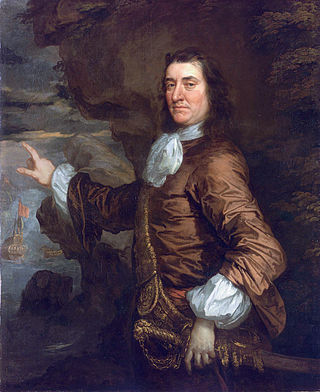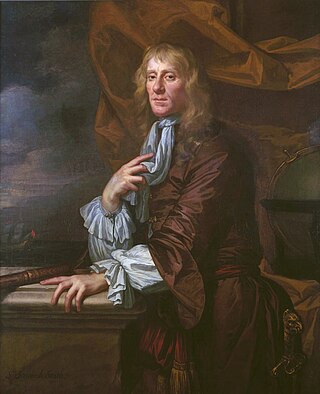
The Second Anglo-Dutch War, or Second Dutch War, began on 4 March 1665, and concluded with the signing of the Treaty of Breda on 31 July 1667. One in a series of naval conflicts between England and the Dutch Republic, its causes were a combination of political differences and commercial disputes.

Michiel Adriaenszoon de Ruyter was a Dutch admiral. His achievements with the Dutch Navy during the Anglo-Dutch Wars earned him the reputation as one of the most skilled naval commanders in history.

Royal Charles was an 80-gun first-rate three-decker ship of the line of the English Navy. She was built by Peter Pett and launched at Woolwich Dockyard in 1655, for the navy of the Commonwealth of England. She was originally called Naseby, named in honour of Sir Thomas Fairfax's decisive 1645 victory over the Royalist forces during the English Civil Wars. She was ordered in 1654 as one of a programme of four second rates, intended to carry 60 guns each. However, she was altered during construction to mount a complete battery of guns along the upper deck, and so was reclassed as a first rate.

The Battle of Lowestoft took place on 13 June [O.S. 3 June] 1665 during the Second Anglo-Dutch War. A fleet of more than a hundred ships of the United Provinces commanded by Lieutenant-Admiral Jacob van Wassenaer, Lord Obdam, attacked an English fleet of equal size commanded by James, Duke of York, forty miles east of the port of Lowestoft in Suffolk.

The Eendracht or Eendragt was the flagship of the confederate navy of the United Provinces between 1655 and 1665. Eendragt was the more common spelling in the 17th century; Eendracht is the modern Dutch standard spelling.

Egbert Bartholomeuszoon Kortenaer or Egbert Meussen Cortenaer was an admiral of the United Provinces of the Netherlands who was killed in the Battle of Lowestoft.

Jacob, Banner Lord of Wassenaer, Lord Obdam, Hensbroek, Spanbroek, Opmeer, Zuidwijk and Kernhem was a Dutch nobleman who became lieutenant admiral, and supreme commander of the navy of the Dutch Republic. The name Obdam was then also spelled as Opdam. British contemporaneous sources typically refer to him as Admiral Opdam or Lord Obdam because it was not until 1657 that he bought the Wassenaar Estate from relatives and thus acquired its title. Modern Dutch sources sometimes less correctly insert a second "van" between "Wassenaer" and "Obdam" or use the modern spelling "Wassenaar".

Willem van der Zaan was a Dutch Admiral. His name is often given in the 17th century spelling Zaen.

The ships that participated in the Battle of Lowestoft, a naval engagement between the English and Dutch off the English port of Lowestoft on 13 June 1665 during the Second Anglo-Dutch War. 95 English ships, commanded by James Stuart, Duke of York, faced 107 Dutch ships led by Jacob van Wassenaer, Baron Obdam. The battle ended in a victory for the English, capturing 9 Dutch ships and sinking 8 others, for the loss of only one ship.

Adriaen van Trappen Banckert was a Dutch admiral. In English literature he is sometimes known as Banckers. His first name is often rendered in the modern spelling Adriaan. Van Trappen was the original family name, but the family was also and better known under the name of Banckert. In the 17th century Netherlands such a situation was solved by combining the two names.

Cornelis Evertsen the Youngest was a Dutch naval officer from Vlissingen who served as Lieutenant Admiral of Zeeland and Supreme Commander of the Confederated Dutch Navy. Of a family that included several other naval admirals, including his father, Evertsen is noted for his distinguished service during the Second Anglo-Dutch War, Third Anglo-Dutch War, the Franco-Dutch War, the Glorious Revolution invasion, and the Battle of Beachy Head during the Nine Years' War.
The Admiralty of Rotterdam, also called the Admiralty of de Maze, was one of the five Dutch admiralties in the Dutch Republic.
The naval history of the Netherlands dates back to the 15th century. As overseas trade was a traditional cornerstone of the Dutch economy, naval defence was indispensable for the protection of commercial interests.

Admiral Sir Thomas Allin, 1st Baronet (1612–1685) was an officer of the Royal Navy who saw service in the English Civil War, and the Second and Third Anglo-Dutch Wars. A Royalist during the Civil War, he returned to service after the Restoration and eventually rose to the rank of Admiral of the White after serving under some of the most distinguished military figures of the era, including Prince Rupert of the Rhine.

"Unity makes strength" is a motto that has been used by various states and entities throughout history. It is used by Belgium, Bulgaria, Haiti, Malaysia and Georgia on their coats of arms and is the national motto of Belgium, Bolivia, Malaysia, Georgia and Bulgaria.

Vice-Admiral Sir William Berkeley was a Royal Navy officer who saw service during the Second Anglo-Dutch War, rising to the rank of vice-admiral.

Sir Jeremiah Smith was an officer of the Royal Navy who saw service during the First and Second Anglo-Dutch Wars, rising to the rank of admiral.

Admiral Sir John Harman was an English officer of the Royal Navy, who served first under the Commonwealth, then Charles II following the 1660 Stuart Restoration.















